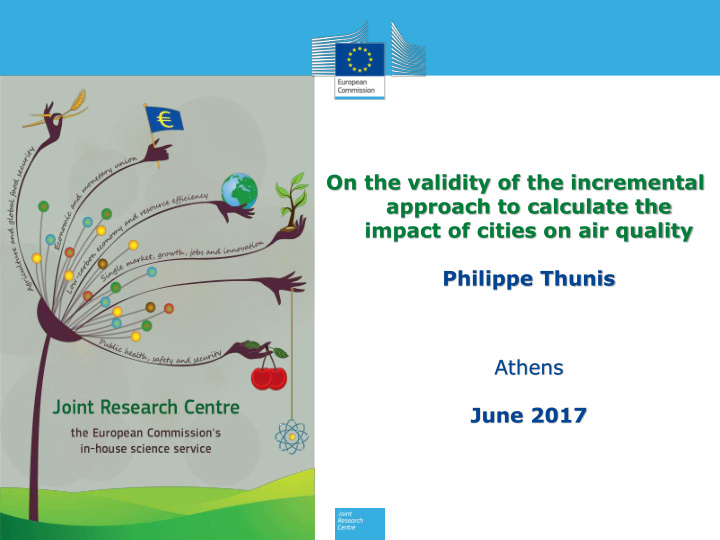



On the validity of the incremental approach to calculate the impact of cities on air quality Philippe Thunis Athens June 2017
Motivations Determine at which level/scale air quality measures should be taken to abate air pollution in the most efficient manner. How can we quantify the contribution of city emissions on its own air pollution? Two main approaches: Incremental CTM scenarios
Urban impact &urban increment
Urban impact &urban increment
Urban impact &urban increment 1. CTM-scenario city city B B ( CTM ) cf cf 2. Lenschow city rur B C d cf ? 5
Urban impact &urban increment city city city C B I cf cf rur rur rur C d B d I d Urban increment cf cf Lenschow Urban imoact City spread city Background deviation city rur I C C d cf I rur d cf rur city B d B cf cf
Urban impact &urban increment Not measurable Measurable Not measurable city city rur rur rur city I C C d I d B d B cf cf cf cf Urb. Impact Urb . Increment city spread Background dev . I rur Assumption I : the city spread is negligible d 0 cf The rural background location is far enough from the city not to feel its influence rur city Assumption II : the background is homogeneous B d B cf cf The city and rural background locations should not be too far from each other 7
SHERPA assessment in 4 cities city city rur rur rur city I C C d I d B d B cf cf cf cf Urb. Impact Urb . Increment city spread Background dev . SHERPA How do these components vary with distance (d) With city fraction (cf) With city: Berlin, Paris, London, Bruxelles With pollutant: PM 2.5 and NO 2
SHERPA assessment in 4 cities 12 12 8 9 3 2 City fractions FUA 5 2.4 Urban core 3.5 1.1 Inner city 9
PM 2.5 for cf = FUA Background deviation City spread Lenschow increment 10
PM 2.5 for cf = urban core Background deviation City spread Lenschow increment 11
PM2.5 for cf = inner city city rur B B ( d ) cf cf
PM2.5 for cf = inner city Background deviation Lenschow increment City spread
Summary overviews 14
Comparison of obs. and mod. Increments (PM 2.5 ) 15
Conclusions The urban increment ( LUI ) is an appropriate estimate of the urban impact ( I ) only when two assumptions are fulfilled: The city spread is negligible The background deviation is negligible For PM 2.5 , these two assumptions are never fulfilled for large or medium cities and the LUI underestimates the urban impact by 30 to 50%. Although it works better for NO 2 some underestimation is also found for this pollutant. 16
Conclusions (cont.) Given that: The urban impact is very sensitive to the size of the city fraction The urban increment is very sensitive to distance (d) and location the urban increment seems to be a poor proxy for estimating the urban impact. Studies based on the incremental approach are very likely to underestimate (heavily for PM 2.5 ) the impact of cities to their air pollution 17
Recommend
More recommend